The Global Humanitarian Assistance Report 2019: Chapter 2
International humanitarian assistance
DownloadsIntroduction
International humanitarian assistance from governments and private donors continued to increase in 2018, reaching US$28.9 billion. This represents growth of almost a third since 2014. This increase has been driven almost equally by public and private donors, with increases of 29% and 32% respectively. Yet the pace of growth has slowed, rising by just 1% from 2017 to 2018. Contributions from public donors drove the overall increase in 2018, as preliminary estimates of private contributions indicated a slight decrease. This represents the first decline in private humanitarian assistance contributions in five years.
In 2018, the amount requested through UN-coordinated appeals rose for the third consecutive year, reaching a new high of US$28.1 billion. This is despite the number of appeals falling from 41 in 2017 to 34 in 2018. Of these 34 appeals, 10 requested more than US$1 billion, collectively accounting for 77% of all requirements. The Syria Regional Refugee and Resilience Plan (3RP) topped appeal requirements again in 2018, requesting US$5.6 billion.
A record volume of funding was committed towards UN-coordinated appeals in 2018, rising by US$1.0 billion from 2017 to US$17.0 billion. This was the third consecutive year in which record volumes of funding were committed. However, requirements remained at the same level as in 2017 (61%), resulting in a shortfall of US$11.1 billion. In 2018, only four appeals received more than 75% of the funds requested, while fifteen received 50% or less.
The well-established trend of a relatively small group of governments and EU institutions providing the majority of international humanitarian assistance continued in 2018. Contributions from the 20 largest public donors increased from US$20.9 billion in 2017 to US$21.9 billion in 2018, accounting for 97% of all international humanitarian assistance provided by governments. Of these 20 donors, only 7 increased their contributions. The most substantial increases were made by the United Arab Emirates (UAE) and Saudi Arabia, providing an additional US$1.7 billion (567% rise) and US$806 million (173% rise), respectively. The three largest donors continued to be the US, Germany and the UK, although all three decreased their contributions in 2018, down by US$423 million (-6%), US$367 million (-11%) and US$271 million (-11%) respectively, from 2017.
International humanitarian assistance
Figure 2.1: International humanitarian assistance increases but pace of growth slows
International humanitarian assistance, 2014–2018
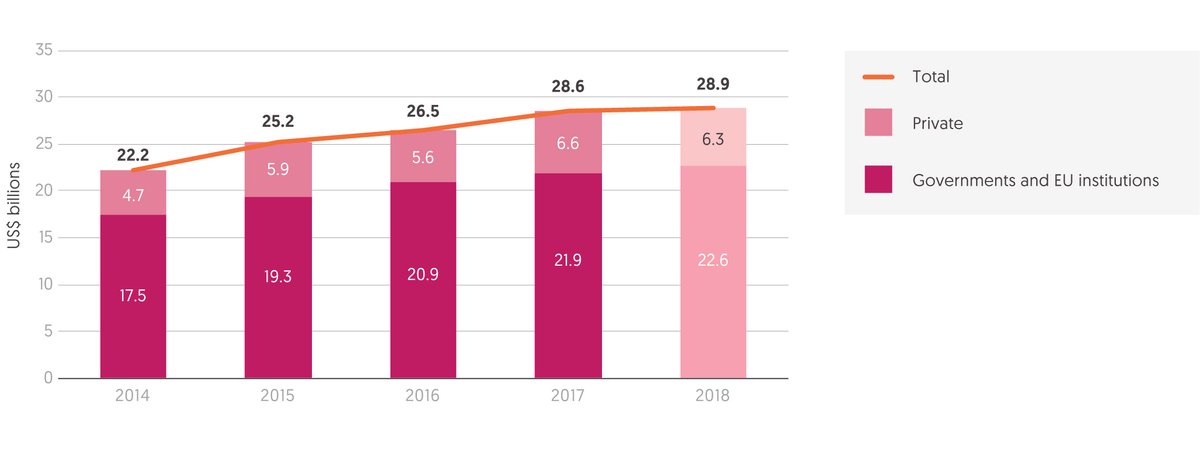
International humanitarian assistance, 2014–2018
Source: Development Initiatives based on Organisation for Economic Co-operation and Development (OECD) Development Assistance Committee (DAC), UN Office for the Coordination of Humanitarian Affairs (OCHA) Financial Tracking Service (FTS), UN Central Emergency Response Fund (CERF) and our unique dataset of private contributions.
Notes: Figures for 2018 are preliminary estimates. Totals for previous years differ from those reported in previous Global Humanitarian Assistance reports due to deflation and updated data and methodology (see our online Methodology and definitions). Data is in constant 2017 prices.
International humanitarian assistance grew by almost a third between 2014 and 2018. However, the pace of growth has slowed, with total contributions increasing by only 1% from 2017 to 2018.
- In 2018, total international humanitarian assistance from governments and EU institutions and estimated contributions from private donors reached US$28.9 billion.
- Over the five years to 2018 total international humanitarian assistance has grown by 30% (US$6.7 billion).
- The growth in total international humanitarian assistance between 2014 and 2018 has been driven almost equally by public and private donors, with increases of 29% and 32% respectively.
- Assistance from governments and EU institutions has grown incrementally over this five-year period, although the pace of growth in contributions has slowed gradually each year, from an increase of 10% in 2015 to one of 3% in 2018.
- In 2018, this increase in contributions from government and EU institutions (rising by US$689 million) sustained the overall growth of international humanitarian assistance, as estimated contributions from private donors reduced by US$378 million to US$6.3 billion.
- The estimated fall in private contributions in 2018 follows growth in three out of four years from 2014 to 2017, from US$4.7 billion to US$6.6 billion.
How did assistance compare with requirements set out in appeals?
Figure 2.2: Appeal requirements and funding reach new highs, while the proportion of unmet requirements is unchanged
Requirements and funding, UN-coordinated appeals, 2009–2018
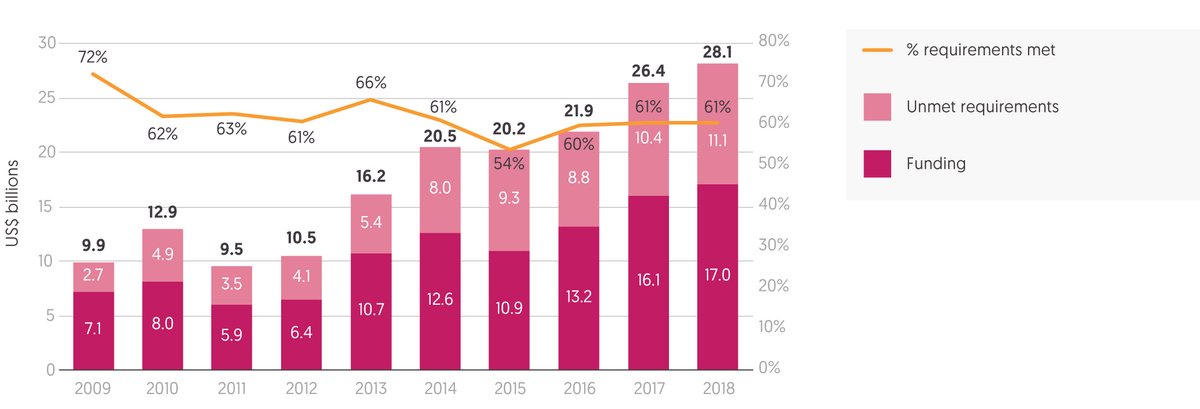
Requirements and funding, UN-coordinated appeals, 2009–2018
Source: Development Initiatives based on Organisation for Economic Co-operation and Development (OECD) Development Assistance Committee (DAC), UN Office for the Coordination of Humanitarian Affairs (OCHA) Financial Tracking Service (FTS), UN Central Emergency Response Fund (CERF) and our unique dataset of private contributions.
Notes: Figures for 2018 are preliminary estimates. Totals for previous years differ from those reported in previous Global Humanitarian Assistance reports due to deflation and updated data and methodology (see our online Methodology and definitions). Data is in constant 2017 prices.
UN-coordinated appeals provide an overview of humanitarian needs and the assistance provided by UN agencies and NGOs to meet these during major crises. In 2018, the amount requested through UN-coordinated appeals reached a record high.
- In 2018, UN-coordinated appeals requested US$28.1 billion of assistance, the third consecutive annual rise.
- This 7% rise continued the upward trend over the past decade – an US$18.3 billion, or 186%, increase since 2009.
- This growth continued despite the number of appeals reducing from 41 in 2017 to 34 in 2018 (the annual average from 2014 to 2018 is 37).
- Driving this aggregate growth were major increases for ongoing crises in the Democratic Republic of the Congo (DRC) (up US$863 million (106%) from 2017 to US$1.7 billion), Yemen (up US$769 million (33%) to US$3.1 billion) and Bangladesh (up US$517 million (119%) to US$951 million).
- The Syria Regional Refugee and Resilience Plan (3RP) (US$5.6 billion) and Syria humanitarian response plans (HRPs) (US$3.4 billion) had the highest appeal targets in 2018, as in 2017, though their requirements were largely unchanged (rising by 0.6% and 0.4% respectively).
A record volume of funding was committed towards UN-coordinated appeals. But the growth in requirements in 2018 outstripped this increase, meaning that the proportion of requirements met was unchanged from 2017.
- In 2018, US$17.0 billion was provided to UN-coordinated appeals, a rise of US$1.0 billion from 2017, and of US$6.1 billion from 2015. This was the third consecutive year in which record volumes of funding were committed to appeals.
- Large increases in the volume of funding received towards appeal targets in 2018 were seen in Yemen (up US$886 million (50%), to US$2.7 billion), Turkey (up US$617 million (125%), to US$1.1 billion) and Bangladesh (up US$343 million (108%) to US$660 million).
- But the rise in funding volume was offset by increases in appeal targets, with 61% of appeal requirements met (a shortfall of US$11.1 billion), as in 2017 (when there was a shortfall of US$10.4 billion). This coverage is consistent with the pattern for the past decade, in which for 8 of 10 years coverage has been between 60% and 66%.
Figure 2.3: Coverage of appeal requirements varies significantly, but 44% of appeals receive half or less of requested funding
UN-coordinated appeal requirements and proportion of requirements met, 2018

UN-coordinated appeal requirements and proportion of requirements met, 2018
Source: Development Initiatives based on UN OCHA FTS and UNHCR data.
Notes: 3RP: Syria Regional Refugee and Resilience Plan; CAR: Central African Republic; DPR Korea: Democratic People’s Republic of Korea. Four regional response plans (RRPs) are shaded to avoid double counting with country humanitarian response plans. Data is in current prices.
The size and level of coverage of appeal requirements varies greatly between appeals. The underfunding of appeals against targets remains a consistent trend. In 2018, a total of 15 out of 34 appeals received 50% of the amount requested or less.
- The 34 appeals in 2018 ranged in size from the Syria 3RP requesting US$5.6 billion, to the Senegal appeal requesting US$16.8 million.
- In 2018, 10 appeals requested over US$1 billion (Syria 3RP, Syria, Yemen, South Sudan, DRC, Somalia, South Sudan Regional Response Plan, Ethiopia, Nigeria and Sudan) which collectively represented US$22 billion, 77% of total requests. Yemen and the two Syria appeals accounted for 43% of all appeals (US$12.1 billion).
- The proportion of total appeal requirements met varied greatly in 2018, from Iraq, which received 89% of funds requested, to Haiti, which received just 13%.
- Of the 34 appeals in 2018, only 4 received more than 75% of the funds requested. Fifteen appeals received between 51% and 75% of the appeals target, and fifteen received 50% or less, of which four secured a quarter or less of their appeal requirements.
Analysis of the size of appeal requirements and the level of coverage does not suggest a clear correlation over time. However, 2018 data shows that some countries with multiple and repeated appeals have been poorly funded.
- Larger appeals were better funded in 2018 on average, although the correlation is very weak. All but one appeal over US$1 billion were at least 50% funded while there was wide variation among smaller appeals.
- Among the thirteen appeals that received less than 50% of their requirements, [1] eleven had appeals for two or more consecutive years in 2018.
- In 2018, 15 countries with HRPs were identified as ‘forgotten crises’ in the European Civil Protection and Humanitarian Aid Operations (ECHO)’s latest assessment. On average these 15 appeals requested US$222 million. Seven of these crises received 50% or less of requirements (the average for all fifteen crises was 49%).
- Of the sixteen countries that have had five or more consecutive years of appeals, five received less than 50% of requested funding in 2018. Three of the five countries with appeals for ten or more consecutive years (Central African Republic, Palestine and DRC) received less than 50% of requirements in 2018. The remaining two (Somalia and Chad) received less than 60%.
Red Cross appeals
The International Red Cross and Red Crescent Movement (RCRC) sets out its requirements separately from the UN-coordinated appeals. In 2018, funding to the International Committee of the Red Cross (ICRC) and International Federation of Red Cross and Red Crescent Societies (IFRC) appeals increased from 2017.
ICRC appeals respond mainly to conflict-related situations.
- In 2018, the ICRC received US$1.7 billion, a 4.3% increase from 2017 (US$1.6 billion). Since 2014 ICRC funding has grown by 29%.
- With this increase in funding, the ICRC was able to cover 94% of its US$1.8 billion appeal requirements. Since 2014, coverage has averaged 92%.
IFRC emergency appeals relate mostly to disasters associated with natural hazards.
- In 2018, the IFRC received US$372 million, a 30% increase from 2017. Since 2014 IFRC funding has grown by 10%.
- The IFRC covered 79% of its US$473 million appeal requirements in 2018. Since 2014, coverage has averaged 83%.
International government funding: largest donors
Figure 2.4: The three largest donors of international humanitarian assistance – US, Germany and UK – account for over half of all such assistance
20 contributors of the largest amounts of international humanitarian assistance, governments and EU institutions, 2018
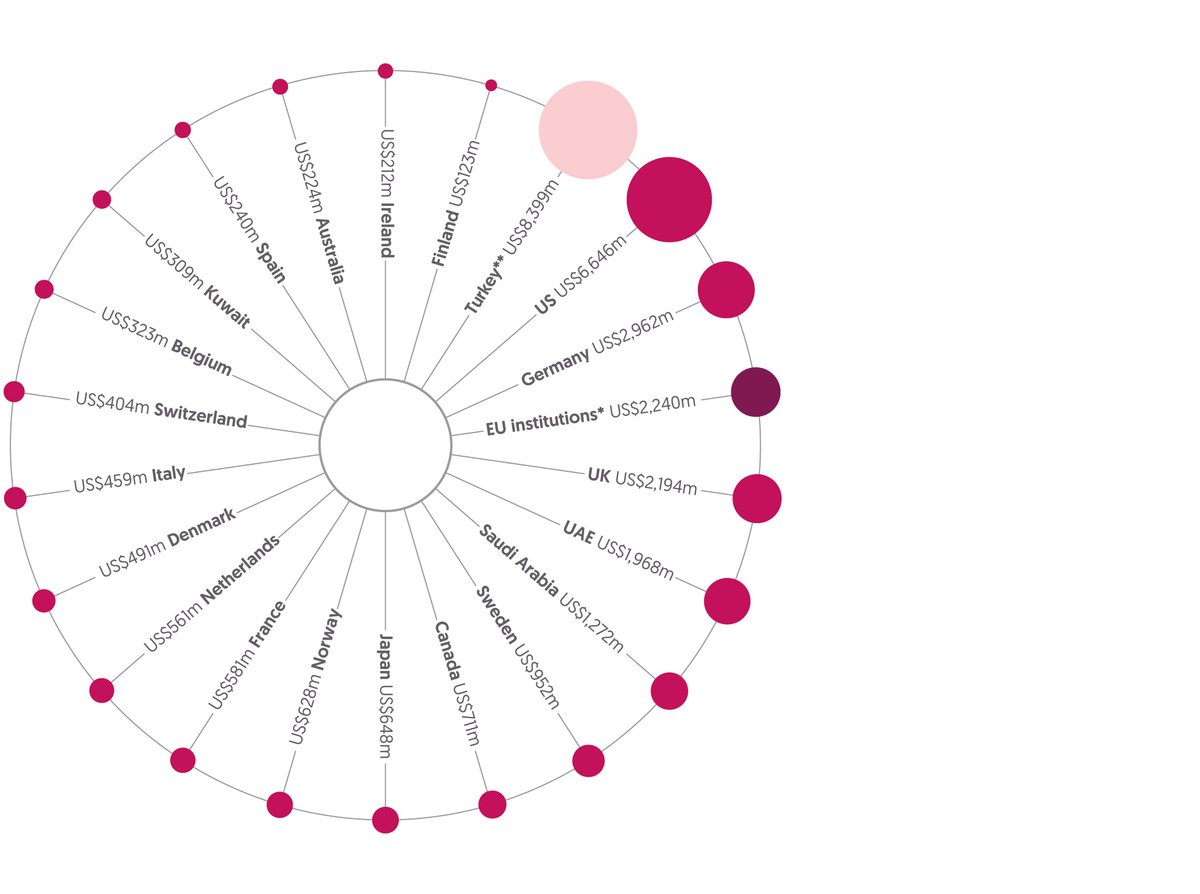
20 contributors of the largest amounts of international humanitarian assistance, governments and EU institutions, 2018
Source: Development Initiatives based on OECD DAC, UN OCHA FTS and UN Central Emergency Response Fund (CERF) data.
Notes: UAE: United Arab Emirates. 2018 data for OECD DAC is preliminary. Contributions of EU member states include an imputed amount of their expenditure (see our online Methodology and definitions).
*EU institutions are also included separately for comparison and are shaded differently to distinguish from government donors.
**Turkey is shaded differently because the humanitarian assistance it voluntarily reports to the DAC largely comprises spending on hosting Syrian refugees within Turkey and is not therefore strictly comparable with the international humanitarian assistance from other donors in this figure.
Data is in constant 2017 prices.
The well-established trend of a relatively small group of governments, along with EU institutions, providing the majority of international humanitarian assistance continued in 2018.
- The volume of international humanitarian assistance provided by the 20 largest public donors increased from US$20.9 billion in 2017 to US$21.9 billion in 2018, accounting for 97% of all international humanitarian assistance provided by governments.
- The proportion of total contributions provided by the three largest donors in 2018 (the US, Germany and the UK) decreased from 59% in 2017 to 52%, driven by an absolute fall in assistance from each donor. [2]
- The US continued to be the single largest donor, though its contributions accounted for a smaller proportion, 29%, of all public funding for humanitarian assistance in 2018, decreasing from 32% in 2017.
- Slower annual growth rates in assistance provided by the 20 largest public donors seen in 2017 were consolidated in 2018, when growth rates rose slightly from 4% to 5%. Growth rates have fallen year on year since 2014 (23%, 11%, 8% and 4% from 2014 to 2017 respectively), with 2018 marginally interrupting this trend.
While the overall volume of international humanitarian assistance provided by public donors grew in 2018, this total aggregate growth masks notable fluctuations in the volumes of assistance provided by individual donors.
- In 2018, contributions of international humanitarian assistance from seven of the twenty largest donors increased, with three increasing by more than 10%.
- Of these seven donors, the UAE and Saudi Arabia made very large increases in the volume of assistance provided compared with 2017, contributing an additional US$1.7 billion (a 567% rise) and US$806 million (a 173% rise), respectively. More than 90% of the respective contributions from these countries were directed to the crisis in Yemen in 2018.
- Eight donors decreased their contributions by more than 10%, with the largest proportional reductions being made by Japan, US$237 million (a fall of 27%) and Italy, US$158 million (a fall of 26%).
- While the US, Germany and the UK continued to provide the largest volumes of international humanitarian assistance, all three reduced their contributions in 2018, with respective decreases of US$423 million (-6%), US$367 million (-11%) and US$271 million (-11%).
As Chapter 1 highlights, a large number of countries host refugees, asylum seekers and internally displaced persons (IDPs). Data reported to the Organisation for Economic Co-operation and Development (OECD) Development Assistance Committee (DAC) captures some of the spending on support to refugees in-country; however, expenditure by the majority of countries hosting the largest numbers of forcibly displaced people is not reported. [3] In October 2017, the OECD DAC introduced new guidance for reporting spending on hosting refugees. This guidance gives greater clarity on what spending can, and cannot, be counted as official development assistance (ODA) for the first year in which refugees are hosted. [4]
- In 2018, reported in-country refugee-hosting costs decreased by 28% to US$10.2 billion from the previous year. This follows a fall of 14% from US$16.5 billion in 2016 to US$14.1 billion in 2017.
- Despite reported decreases for two consecutive years, in-country refugee costs in 2018 were still more than two thirds higher (67%) than the total level reported in 2014 (US$6.1 billion).
- Germany, the US and Italy reported the highest refugee-hosting costs in 2018, as they did in 2017, accounting for 37%, 13% and 10% of total hosting expenditures.
- Of the 15 countries with the highest in-country refugee-hosting costs, 12 reported decreases in 2018.
- Reductions in refugee-hosting costs of more than US$300 million were reported by Germany (down US$2.3 billion or 37%), Italy (down US$745 million or 41%), Sweden (down US$306 million or 37%) and the Netherlands (down US$304 million or 36%).
- France, Canada and Spain reported increases in spending from 2017 to 2018 of 10% (up US$52 million), 6% (up US$29 million) and 19% (up US$40 million), respectively.
Figure 2.5: UAE, Kuwait and Saudi Arabia spent the most international humanitarian assistance as a percentage of GNI
20 donors providing the most international humanitarian assistance as percentage of GNI, 2018
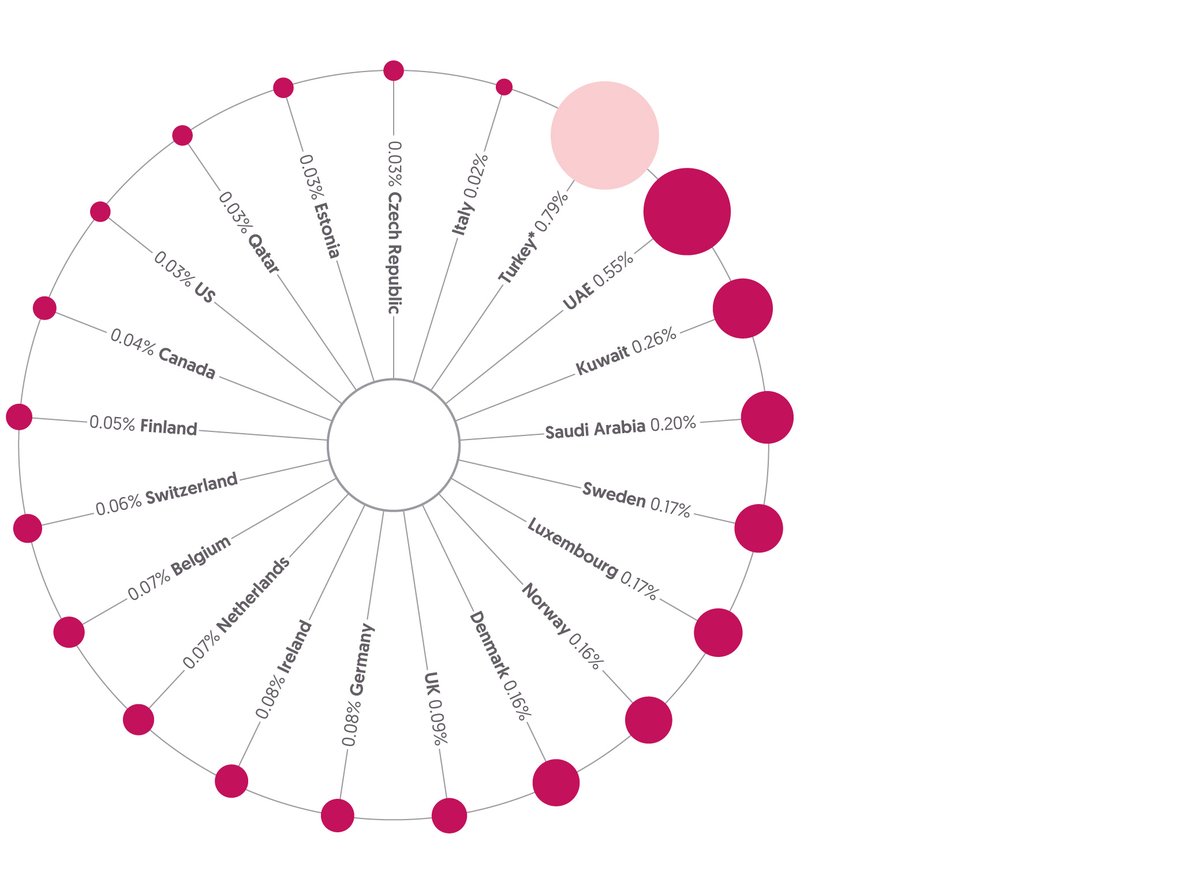
20 donors providing the most international humanitarian assistance as percentage of GNI, 2018
Source: Development Initiatives based on OECD DAC, UN OCHA FTS, UN Central Emergency Response Fund (CERF), World Bank World Development Indicators and International Monetary Fund World Economic Outlook data.
Notes: GNI data for 2018 has been estimated using historical data on GNI and real GDP growth rates for 2018. OECD DAC 2018 data is preliminary. Luxemburg, Qatar, Estonia and Czech Republic are not in the 20 largest donors.
*Turkey is shaded differently because the humanitarian assistance it voluntarily reports to the DAC largely comprises expenditure on hosting Syrian refugees within Turkey, and is not therefore strictly comparable with the international humanitarian assistance from other donors in this figure.
The proportion of GNI spent on international humanitarian assistance indicates the significance of humanitarian spending relative to the size of the economy and other spending priorities. In 2018, three Middle Eastern states made large increases in their proportion of GNI spent as international humanitarian assistance.
- Seven countries contributed more than 0.1% of GNI as international humanitarian assistance in 2018: UAE (0.55%), Kuwait (0.26%), Saudi Arabia (0.20%), Sweden (0.17%), Luxembourg (0.17%), Norway (0.16%) and Denmark (0.16%).
- Large increases were made by the UAE, up from 0.08% in 2017 to 0.55% in 2018, Saudi Arabia, (0.07 to 0.20%) and Kuwait (0.14 to 0.26%).
- The largest donor by volume, the US, contributed only 0.03% of GNI as international humanitarian assistance, the 17th largest share in 2018.
- Turkey’s reported contributions of international humanitarian assistance accounted for 0.79% of GNI in 2018 but are not directly comparable with those of other donors, as the assistance voluntarily reported to the DAC largely comprises spending on hosting Syrian refugees in Turkey.
International government funding: donor regions
Figure 2.6: Growth from Middle East and North of Sahara outstrips contraction elsewhere
International humanitarian assistance from governments by donor region, 2009–2018
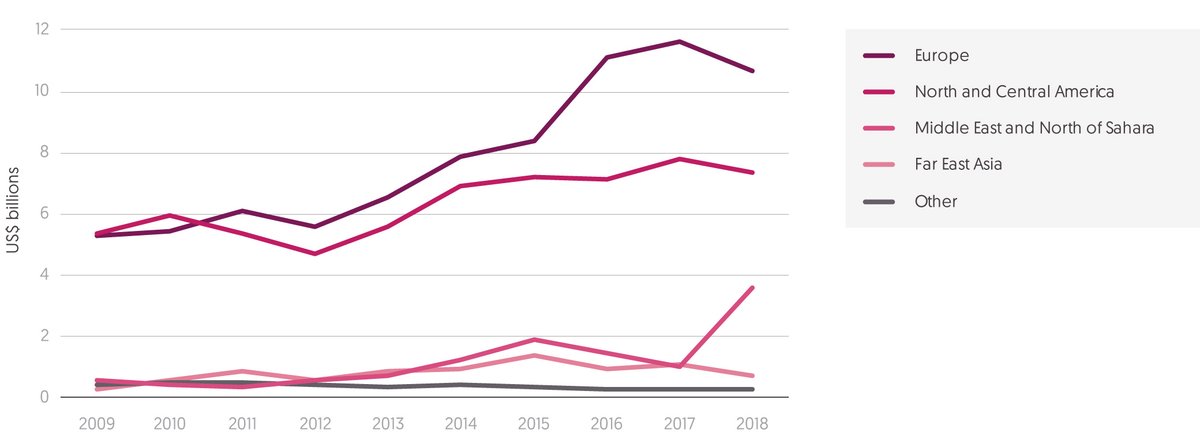
International humanitarian assistance from governments by donor region, 2009–2018
Source: Development Initiatives based on OECD DAC, UN Central Emergency Response Fund (CERF) and UN OCHA FTS data.
Notes: OECD DAC data for 2018 is partial and preliminary. Funding from DAC donors includes contributions from EU institutions. OECD country naming has been used for regions, except Middle East and North of Sahara, which have been combined. ‘Other regions’ includes the combined total of regions where funding was below US$1 billion over the 10-year period. Calculations only include humanitarian assistance spent internationally, not in-country. See our online Methodology and definitions. Data is in constant 2017 prices.
In 2018 there were notable variations in the volume of assistance from different regions. Funding from governments in Europe and North and Central America fell while assistance from the Middle East and North of Sahara rose sharply.
- In 2018, combined bilateral contributions from European governments and EU institutions fell by 9%, the first fall since 2012. Assistance from Europe reduced from US$11.7 billion in 2017 to US$10.6 billion in 2018, making up 47% of total bilateral assistance.
- Driving this decrease were falls of 11% from Germany (from US$3.3 billion to US$3.0 billion) and the UK (US$2.5 billion to US$2.2 billion); the first decreases since 2012.
- The volume of bilateral international humanitarian assistance provided by countries in North and Central America also decreased, falling from US$7.8 billion in 2017 to $7.4 billion in 2018.
- Contributions from the US and Canada fell in 2018 by 6% and 3%, respectively, to US$6.6 billion and US$711 million. However, assistance from these two countries has grown markedly over the past decade, increasing by 33% and 106%, respectively, since 2009.
- Counterbalancing these falls in international humanitarian assistance was a sharp increase in contributions from countries in the Middle East and North of Sahara. Contributions grew by 247%, up US$2.6 billion from 2017, to US$3.6 billion in 2018, following two years of falling volumes of assistance.
- Assistance from the UAE and Saudi Arabia accounted for most of this increase, up US$1.7 billion (567%) and US$806 million (173%), respectively.
- The share of total bilateral humanitarian assistance represented by contributions from the Middle East and North of Sahara has seen uneven growth and contraction. This region’s share of total contributions was 5% in 2013, growing to 10% by 2015, reducing back to 5% by 2017, before rising sharply to 16% in 2018.
Private donors
Figure 2.7: Around two thirds of private contributions continue to come from individuals
Sources of private international humanitarian assistance, 2013–2017
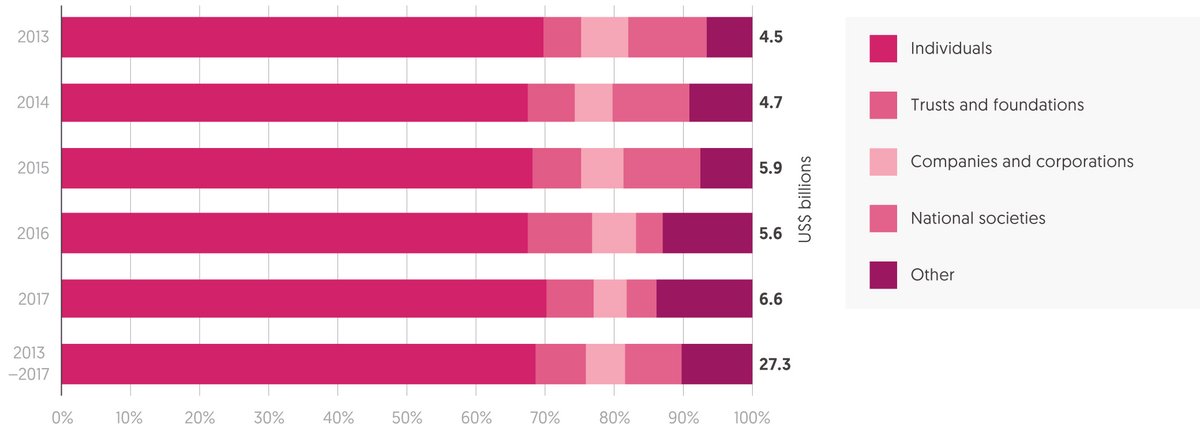
Sources of private international humanitarian assistance, 2013–2017
Source: Development Initiatives based on our unique dataset of private contributions.
Notes: Data is in constant 2017 prices.
Contributions of international humanitarian assistance by private donors have played a consistently important and substantial role in financing responses to crises, with overall contributions growing by 49% between 2013 and 2017. [5] Analysis of the different sources of private contributions shows the proportion of total funding from national societies has decreased since 2015 but limited variation between 2013 and 2017 among other private sources.
- For the fifth consecutive year, individual giving remained the largest source of privately contributed humanitarian assistance in 2017, making up 70% (US$4.7 billion) of the total.
- The volume and proportion of private humanitarian assistance provided by trusts and foundations fell slightly – following three consecutive years of growth – from US$518 million, or 9% of total contributions, to US$460 million, or 7%. This proportion of total contributions is consistent with the average from 2013 to 2017 of 7%.
- The share of contributions from national societies decreased from 11.3% in 2015 to 3.8% in 2016 as volumes of assistance reduced from US$667 million to US$212 million. In 2017, contributions from national societies slightly increased to US$280 million (4.2% of total private contributions).
- In 2017, NGOs continued to receive a greater proportion of funding from private sources than other types of organisations did. NGOs received 44% of total humanitarian assistance from private donors, a far greater proportion than RCRC National Societies (14%) or UN agencies (9%).
Box 2.1
Data availability for private donors
Openly reported data on private contributions of international humanitarian assistance is limited. UN OCHA’s Financial Tracking Service (FTS) and the OECD DAC’s Creditor Reporting System (CRS) capture some data but this represents only a small proportion (likely to be less than 10%) of all private contributions. Few private donors voluntarily report to the FTS and it is not currently possible for agencies to directly indicate whether the funding they received was from institutional or private sources. Given the low level of existing reporting, Development Initiatives (DI) manually collects data directly from humanitarian agencies. This data allows DI to establish a more comprehensive picture of private funding for international humanitarian assistance, although figures are estimates of total contributions.
UN OCHA FTS
- While data presented by UN OCHA’s FTS represents the most comprehensive and up-to-date information on humanitarian financing, some funding flows, in particular those from private sources, are either entirely absent or only partially represented.
- There is no direct mechanism by which reporting agencies can specify whether the contributions reported to FTS are institutionally or privately funded, although it is clear that there is a lack of representation of private donors.
- The categorisation of donor organisations does provide some insight into the levels of private contributions that have been reported to FTS. With DI coding applied, in 2017, contributions from exclusively private sources amounted to US$396 million, or 2% of total international humanitarian assistance reported to FTS that year.
OECD DAC CRS
- The OECD CRS dataset for Private Philanthropy for Development presents data for activities in support of development, or humanitarianism, from philanthropic foundations.
- The data presented by OECD, while reliable, is very limited in its scope. The information section for the database notes that “collecting data on private philanthropy for development is a work in progress, which may explain breaks in series for some foundations.” [6]
- In 2017, the total humanitarian private contributions captured amounted to US$130 million, sourced from ten foundations and three society lotteries.
- The 2017 volume of reporting improved on that of previous years, although it remains a fraction of the amount of private humanitarian contributions captured by DI’s dataset. The 2017 figure represented a ten-fold increase in the quantity of private humanitarian contributions reported to the CRS in five years; in 2012, the dataset only captured US$13.6 million in private funding.
DI dataset
- DI directly requests financial information from humanitarian delivery agencies (including NGOs, multilateral agencies and the RCRC) on their income and expenditure to create a standardised dataset.
- DI’s figure is an estimate of total humanitarian assistance sourced from private donors. The data available for the most recent year, 2018, is more limited as many organisations have not yet completed internal accounting processes. As such the 2018 figure is preliminary and based on an extrapolation from the data currently available.
- In some instances, it is impossible to find out exactly how much of the private donor figure was for humanitarian activities. In these cases, the proportion of total organisation-wide expenditure spent on humanitarian programmes has been used to calculate the figure.
Downloads
Notes
-
1
We note that 15 appeals received 50% or less of their requirements. These included ten countries with HRPs, four RRPs (Burundi, DRC, Nigeria and South Sudan) and one Needs and Priorities Plan (DPR Korea).Return to source text
-
2
Turkey and EU institutions are not included in these calculations. In 2017, the three government donors that contributed 59% of the total (US$11.8 billion) were the US, Germany and the UK.Return to source text
-
3
See Chapter 1, Figures 1.3, 1.4 and 1.5. A large number of countries outside the DAC provide support to refugee and IDP populations; of the 20 countries with the largest forcibly displaced populations, only Germany and the US are DAC members. As well as these two countries, Turkey also voluntarily reports some in-country refugee-hosting costs to the DAC (US$24.3 million), though most of the spending it reports to the DAC as humanitarian assistance is also used to support Syrian refugees. Data on expenditure by other hosting countries is not reported to the DAC, making comparative analysis difficult.Return to source text
-
4
Agreed in October 2017, the revised OECD DAC guidelines state that in-donor refugee costs are only those reported under the specified ODA category code. Other spending on refugee hosting in these countries that is not reported to this code in not included (see OECD, 2017. DAC High Level Communiqué: 31 October 2017. Available at: www.oecd.org/dac/DAC-HLM-2017-Communique.pdf ). The revisions aim to enhance the consistency of reporting between donors as well as transparency of reported costs. For analysis of these guidelines, see Development Initiatives, 2017. ODA Modernisation: An update following the October 2017 HLM. Available at: http://devinit.org/post/oda-modernisationupdate-following-october-2017-hlmReturn to source text
-
5
2017 is the most recent year for which detailed data is available to identify sources of private contributions. The preliminary figures used to estimate contributions for 2018 are drawn from a more limited and less detailed dataset because, at the time of publication, many organisations have yet to complete internal accounting processes and publish full financial records for 2018.Return to source text